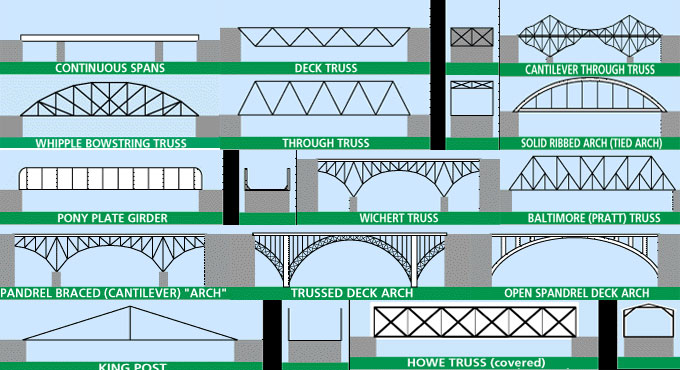
Fundamentals of fixed (non-movable) bridge types
In this construction article, one can get useful information on mostly used fixed (non-movable) bridge types.
Generally, the bridges are categorized on the basis of the following four main factors.
a. span (simple, continuous, cantilever),
b. material (stone, concrete, metal, etc.),
c. lacement of the travel surface in relation to the structure (deck, pony, through),
d. form (beam, arch, truss, etc.).
The three basic types of spans are built up with beams, girders or trusses. Arch bridges belong to either simple or continuous (hinged). A cantilever bridge may also comprise of a suspended span.
There exist three common travel surface configurations. In a Deck configuration, traffic passes through on top of the principal structure; in a Pony configuration, traffic passes through among parallel superstructures which are not cross-braced at the top; in a Through configuration, traffic passes through the superstructure (normally a truss) which is cross-braced over and underneath the traffic.
Beam and Girder types: Simple deck beam bridges are normally made of metal or reinforced concrete. Metal is used to build up other types of beam and girder. The end section of the two deck configuration demonstrates the cross-bracing generally utilized among beams. The pony end section demonstrates knee braces to resist deflection where the girders and deck intersect.
By inserting haunches at the supported ends, it become possible to enhance the load capacity of the girder whereas reduce it?s web depth. Normally, the center section is a standard shape with parallel flanges; curved or angled flanged ends are riveted or joined with splice plates. Due to the hindrances which occur for carrying the large beams to the construction site, shorter, more controllable lengths are commonly affixed on-site through splice plates.
New designs are applied on various modern bridges which are created with computer stress analysis. The rigid frame type contains superstructure and substructure which are combined. Normally, the legs or the junction of the leg and deck are a single piece that is bolted with other sections.
The shapes of orthotropic beams are modular and they defend stress in several directions promptly. They fluctuate in cross-section and may be open or closed shapes.

To gather more information, go through the following link pghbridges.com

